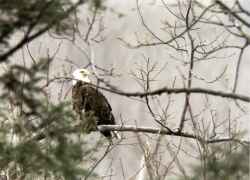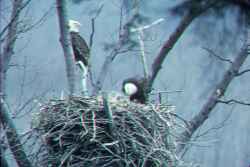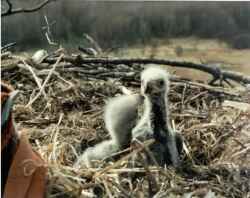Historical records indicate that at least seventy-two bald
eagle nesting territories are previously known to have existed
in New York. (NYS Dept. of Environmental Conservation) Although
this number is verifiable, it is undoubtedly conservative. Our
national symbol is primarily a fish eater and given the exceptional
quality of New York's fisheries resource, these magnificent birds
have unquestionably been a common sight in the skies over the
Empire State since the creation. However, by 1976, only one active
territory was known to remain in the entire state.  That
site, known as NY #1, is located in the heart of the Finger Lakes
on property owned by the City of Rochester. During the decade
prior to our nation's bicentennial, this territory had seen only
one eaglet produced. While the resident pair of eagles struggled
to breed on an annual basis, sustained accumulations of organo-chlorine
pesticides (primarily DDT) over several decades, and the resulting
reduction in egg shell thickness, had all but sealed the fate
of New York's native eagle population. That
site, known as NY #1, is located in the heart of the Finger Lakes
on property owned by the City of Rochester. During the decade
prior to our nation's bicentennial, this territory had seen only
one eaglet produced. While the resident pair of eagles struggled
to breed on an annual basis, sustained accumulations of organo-chlorine
pesticides (primarily DDT) over several decades, and the resulting
reduction in egg shell thickness, had all but sealed the fate
of New York's native eagle population.
In late 1975, acting on anticipated funding from the Endangered
Species Act of 1973, the Department of Environmental Conservation
(DEC) embarked on what would soon become the most ambitious bald
eagle restoration effort in the nation. The period between 1976
and 1988 saw an unprecedented attempt to revive New York's once
flourishing eagle population through a process known as "hacking."
Utilizing this ancient falconry technique, eaglets were obtained
from wild nests as far away as Alaska, or from captive breeding
sources. These birds were taken to predetermined sites where they
were monitored and cared for until they were ready to venture
out on their own. Conceptually, if a large enough number of trans-located
eaglets could survive to maturity (4-5 years) there was an excellent
probability that they might establish new breeding territories
in both historic and newly created habitats within the state.
During that thirteen-year period, nearly two hundred young bald
eagles were hacked to the wild. Many of those birds and their
descendants today form the base for New York's expanding bald
eagle community.
By the end of the 2001 eagle nesting season, at least sixty-five
territories are known to exist across New York. If that number
is not exciting enough, these territories produced more than eighty
young. Additionally, it can be said with assurance that there
are other sites that have yet to be discovered or reported. Even
more encouraging is the fact that New York is not alone in this
achievement. Many other states throughout the "lower forty-eight"
have seen, or are beginning to see, comparable increases in eagle
nesting numbers. What a difference a quarter century can make!
As the eagle hacking project emerged in 1976, a second, though
less intensive effort, was begun in an attempt to maintain activity
at that one remaining territory. Although the birds at this site
had a poor track record for breeding successfully, it was considered
fundamental that the territory remain active. Essentially, having
eagles to "help," was the first step in helping the
eagle population. Not to mention that extirpation was not a term
that was looked upon favorably. Crucial in this effort would be
the acquisition of a basic understanding of what transpired during
the breeding cycle. Several necessary steps were undertaken that
initial year (1976) in an attempt to better secure the site and
reduce the risk of nest disturbance, in the event that had played
a part in previous failures. The first step was the establishment
of a cooperative agreement between the City of Rochester who,
as mentioned earlier, owns the property, and the Department of
Environmental Conservation, who would monitor the site. This agreement,
which remains in effect today, not only paved the way for the
protection of the eagles and their territory, but has become a
gleaming example of cooperation between agencies. It allows for
the restriction of general access which reduces the likelihood
of nest abandonment, while permitting activities (such as this
webcam) which are judged to be legitimate for the overall management
of the territory. Additionally, a predator guard was installed
on the base of the nest tree to prevent mammalian predation of
the eggs or young. This potential threat was taken very seriously
because of a healthy raccoon population in the area. Even though
eagles usually nest high in a treetop, raccoons are capable and
willing to make that climb. The egg(s) or young eagles present
in the nest can easily fall prey to a hungry raccoon. Unfortunately,
even though adult eagles are large and fierce in appearance, they
are frequently timid when it comes to protecting the nest and
its contents. Finally, during the late fall of 1976, an observation
blind (or hiding place) was constructed a mere fifty yards away
from the nest tree so daily activities could be extensively documented.
After careful monitoring of the site through the 1977 season,
it was determined in early 1978 that an attempt would be made
to "foster" an eaglet, hatched in captivity, into the
nest. Fostering is a procedure in which eaglets (usually two to
three weeks of age) are placed in a nest with an expectation that
the resident adults will accept and raise the bird(s) as if they
were their own. Much like our human foster parent counterparts.
This was deemed to be a bold step as it had only been successfully
undertaken a few times before, and never in New York. On April
24, 1978, a nineteen day old eaglet hatched at the U. S. Fish
and Wildlife Service's Patuxent Wildlife Resource Center, was
substituted for the egg present in the nest. |
The adult eagles were approximately three weeks into the incubation
of that egg and no one knew how this disturbance would be received.
Approximately forty five minutes after the climbing team left
the area, the female returned to perch on a branch adjacent to
the nest. A few moments later she moved over to the massive structure
and began to brood the eaglet. And what about Dad? Well, there
are those that might say, "typical male" as it proved
to be several  hours
before he finally worked up the courage to return. When he did
however, he brought back a small fish, which the female received
from him, and ever so gently began to feed their adopted youngster. hours
before he finally worked up the courage to return. When he did
however, he brought back a small fish, which the female received
from him, and ever so gently began to feed their adopted youngster.
This process was repeated annually over the next five years
and a total of seven additional foster young took flight into
the New York skies.

|

